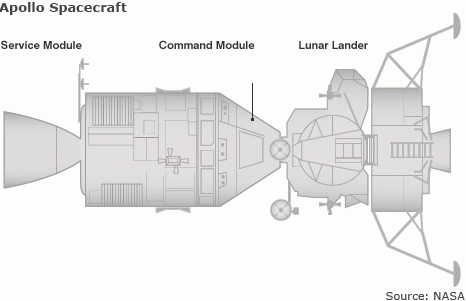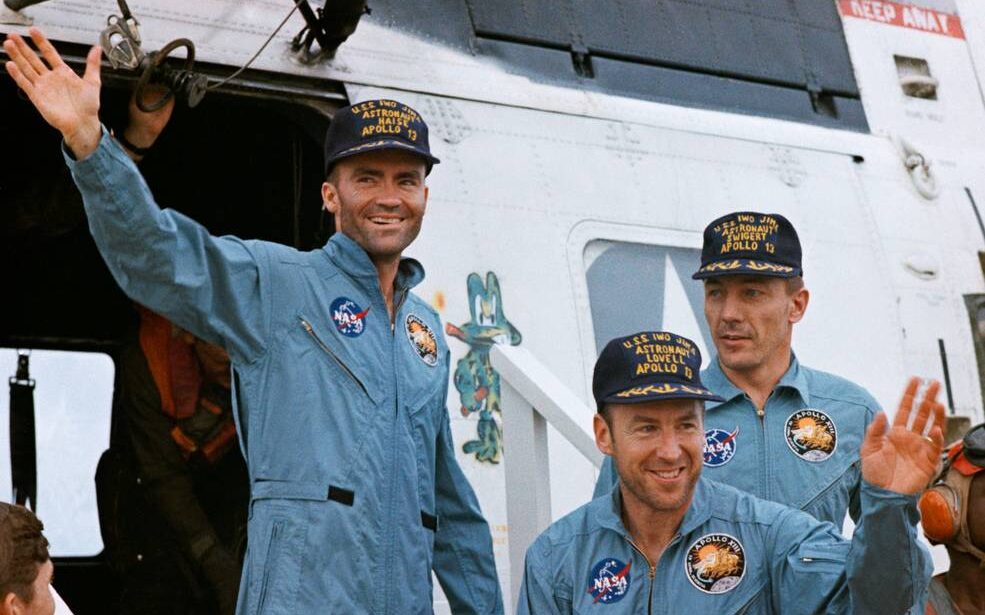The real space rescue missions of history.
by Nadiya Ivahnenko, Galactic Challenge Volunteer
Monday, April 13th 1970
7.07 pm PST

56 hours into a mission, an explosion begins to shake a rocket headed for the moon. 205, 000 miles away alarm lights begin to flash at mission control on earth. Oxygen tank 2 has exploded, a whole side of the spacecraft is missing and three men are on board a space vessel that is seconds away from losing all power.
The Apollo 13 mission would mark the third manned landing on the moon, ultimately arriving at the bright plains of the Fra Mauro lunar highlands. The landing site promised to be dangerous with unpredictable hills, but with a wealth of scientific information from the remains of one of the largest craters discovered within the solar system; looking out of your window at night, you can see it for yourself as the darkest spot on the Moon! (See left)
April 11th 11.13 am
The crew of Apollo 13 climbed onto the Saturn V Rocket at Florida’s Kennedy Space Station. Meanwhile dozens of scientists, engineers and technicians stand by at mission control at Houston, Texas in the US, prepared to monitor the millions of moving parts on board. After lift-off the astronauts entered Earth’s atmosphere, bracing themselves as the engines ignited and roared to life, shaking the ground around it. The first stage is successful and soon the rocket hurtles through the sound barrier – travelling faster than the speed of sound!
Strapped into their seats the astronauts furiously shake with the ship around them, as they ‘pogo’ into space. Suddenly the first alarm starts to ring as the centre engine fails – the first unexpected danger on their trip. Nonetheless, the team has planned for this and the computer onboard detects the failure, quickly powering up the remaining engines to recover.
The astronauts continue their course and are ready for a three-day journey to the Moon.
In the meantime, the astronauts wait, monitor the ship, and broadcast on TV every evening, showing the world as they travel deeper into space. Unknown to anyone, damage had emerged on the mission’s oxygen tank during testing, waiting for an ultimate disaster. See the Apollo 13 spaceship below, made up of service and command modules, alongside a lunar lander.

Two days after leaving Cape Canaveral, the crew is instructed to turn on the fans in the oxygen tank as part of a routine procedure, stirring the super-cold liquid oxygen inside. A bang rings out through the ship.
The astronauts gather in the command module to try and discover the cause of the explosion. The commander, Jim Lovell, radios mission control delivering a daunting message:
“Houston, we have a problem”.
Seconds later the plumes of oxygen are escaping into space and the fuel cells have failed causing power onboard to drop rapidly. Immediately both the crew on earth and in space are in a race against time, working against the odds to ensure the astronauts return safely. Across the world, people listen in on radio and TV news broadcasts as the events of the rescue mission unfold.
The mission is aborted and the crew move into the service module originally intended to land them on the Moon, now they must use it as a lifeboat. New computer code is drafted, radioed to the crew and punched into the onboard computer. For four minutes and 23 seconds the lunar lander’s engines fire and the crew manoeuvre around the moon, assisted by its gravity, and Apollo 13 has successfully begun its journey home.
However, the two-person lunar lander soon is unable to provide clean air for the three astronauts tightly squeezed on board. Using only the materials onboard the lander, an air hose from a spacesuit is cut and reattached to canisters onboard allowing breathable air to re-enter the lander.
Slowly earth reappeared in the windows of the ship. As they travelled more problems emerged: the engine had to be refired in bursts so the lander would not run out of fuel and miss the earth by 2,500 miles; a precise pressure had to be calculated to separate the astronauts from the unused modules of the ship; and lastly the astronauts needed to parachute into waves of the South Pacific Ocean.
At the time of the first explosion, there was a 10% chance that the mission would return. Still the mission persevered, and finally through creativity and improvisation the crew of Apollo 13 returned home. Though the mission failed in its original goal, Apollo 13 demonstrated the lengths that human teamwork could achieve. Still today, every mission into space carries the risk of no return, as well as a team of people waiting for the unexpected. Since Apollo 13, many astronauts have had to encounter near-disasters and many have been prepared to once again radio back the same message as Jim Lovell, “Houston, we have a problem”.

The crew of Apollo 13, after landing back on Earth
Sources:
- https://www.nasa.gov/feature/50-years-ago-apollo-13-crew-returns-safely-to-earth/
- https://www.awesomestories.com/asset/view/Apollo-13-Accident
- https://www.seekpng.com/ima/u2a9o0i1q8i1q8a9/
- https://www.space.com/17250-apollo-13-facts.html
- https://www.youtube.com/watch?v=Cz27UNHsXDc
- https://www.spokesman.com/frontpage/2020/apr/13/further-review/
- https://www.space.com/29078-how-apollo-13-moon-accident-worked-infographic.html

